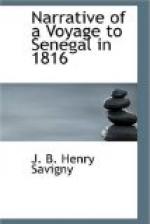A minister, when he is really so disposed, easily finds means to employ an unfortunate man who asks but little.
Such are the vexations which we have experienced since our return to France: now returned to the class of citizens, though reduced to inactivity, after having exhausted our resources in the service, disgusted, forgotten, we are not the less devoted to our country and our king. As Frenchmen, we know that we owe to them our fortune and our blood. It is with the sincere expression of these sentiments that we shall conclude the history of our adventures.
In fine, we think that the reader will not be sorry to have some notices concerning the French settlements on the coast of Africa. As they seemed to us very interesting, we shall examine, but briefly, the places themselves, and the advantages that might be derived from them.
These details will be a happy digression from the sad accounts of our misfortunes, and as the object of them is of great public utility, they will not be out of their place at the conclusion of a work, in which, we have thought it our duty, less for our own interest, than that of the public service, to employ our humble efforts for the disclosure of the truth.
The part of the coast beginning at Cape Blanco, and extending to the arm of the river Senegal, called the Marigot of the Maringouins; is so very arid, that it is not fit for any kind of cultivation; but from that Marigot, to the mouth of the river Gambia, a space, which may be about a hundred leagues, in length, with a depth of about two hundred, we meet with a vast country, which geographers call Senegambia.
Let us remark, however, before we go any further, that, notwithstanding the sterility of this part of the coast; it is not without importance, on account of the rich produce of the sea which bathes it. The agriculture of the waters as a celebrated naturalist has said, offers too many advantages, for the places that are adapted to it, to pass unobserved: this part of the sea, known by the name of the Gulph of Arguin, is especially remarkable for the immense quantity of fish which visit it, at different seasons, or which continually frequent these shores. This gulph, included between Capes Blanco and Merick and the coast of Zaara, on which, besides the isle of Arguin which was formerly occupied, there are several others at the mouth of what is called the river St. John, is as it were closed towards the west, in its whole extent, by the bank which bears its name. This bank, by breaking the fury of the waves, raised by the winds of the ocean, contributes by securing the usual tranquillity of its waters, to render it a retreat for the fish, at the same time that it also favors the fishermen. In fact, it is from this gulph, that all the fish are procured which are salted by the inhabitants of the Canaries, and which constitute their principal food. They come hither every spring in vessels of about 100




